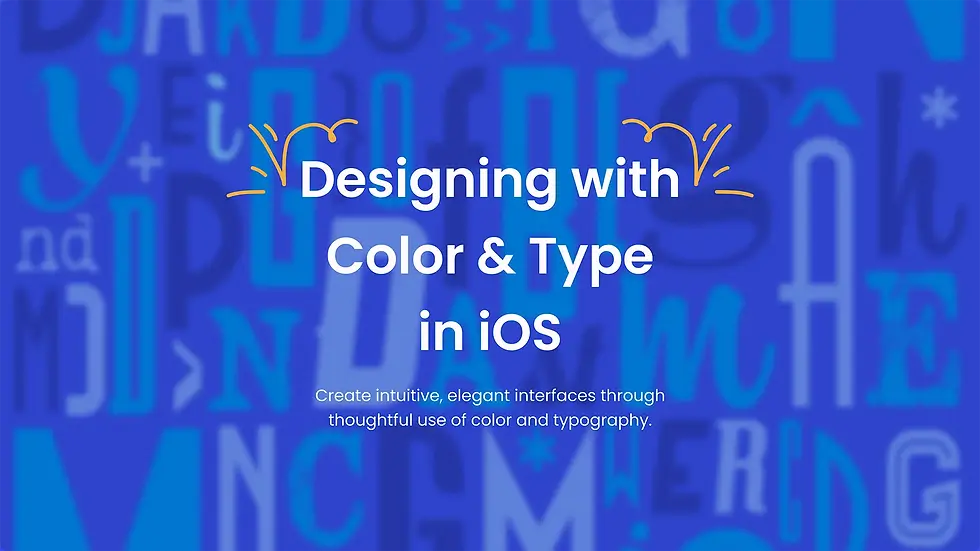Effective Use of Color and Typography in iOS Apps

Color and typography are pivotal in constructing the user interface (UI) for iOS applications. These design components not only boost visual appeal but also have a profound effect on usability and accessibility. By intentionally choosing and applying distinct color palettes and fonts, designers can develop apps that are intuitive, captivating, and easy to use. In the realm of iOS development, where visual precision and sophistication are critical, excelling in these areas is key to providing remarkable user experiences.
Understanding Color Theory
Color Wheel Basics: Primary, secondary, tertiary colors.
Psychological Effects:
Blue = reliability
Red = urgency
Green = vitality/safety
Color Harmony:
Complementary, analogous, triadic schemes.
Creates balanced and attractive visuals.
Invokes feelings and steers user interaction.
To employ color successfully, one must grasp the fundamentals of color theory. This involves an understanding of the color wheel, the role of primary and secondary hues, and the concepts behind complementary, analogous, and triadic schemes. Moreover, colors can stir emotions—blue often represents reliability, red communicates urgency, and green conveys growth or security. Achieving harmonious color combinations ensures the UI remains visually coherent and prevents disruptive contrasts that may detract from user focus.
Color Usage in iOS Apps
Best Practices:
Use a restrained color palette.
Save vibrant hues for interactive components.
Align colors with the brand’s personality and purpose.
Examples:
Instagram: employs a gradient for branding with a predominantly clean UI.
Spotify: uses a striking green accent alongside a dark theme to create immersion.
Accessibility Considerations:
Ensure contrast ratios comply with WCAG standards.
Avoid using color as the sole means of communication.
Utilize iOS tools to simulate color blindness.
Apple’s Human Interface Guidelines advise a minimalist and deliberate use of color to spotlight key elements and preserve visual order. Apps such as Instagram and Spotify effectively incorporate bold accent colors within understated palettes to direct user attention and solidify brand recognition. Accessibility remains paramount; designers must guarantee that text and background contrast are sufficient and not depend exclusively on color to deliver information. iOS offers accessibility utilities to emulate various forms of color blindness, fostering more inclusive design.
Typography Fundamentals
Purpose: Improves readability, organizes structure, and increases engagement.
Font Categories:
Serif – conveys tradition and formality
Sans-serif – offers a clean, modern look (favored on iOS)
Monospace – ideal for technical content
Decorative – utilized sparingly for branding
Typography shapes the overall tone and clarity of the app’s text.
Typography involves more than simply picking a font—it’s about crafting a legible, organized, and engaging text experience. In iOS apps, clear typography supports content digestion and navigational ease. Fonts typically fall into categories such as serif, sans-serif, monospace, and decorative, each catering to different design needs. For iOS, sans-serif fonts, like Apple’s San Francisco, are predominantly chosen for their crisp, contemporary style and excellent legibility.
Choosing the Right Typeface
Criteria:
Legibility across various sizes
Consistency with brand identity
Seamless integration with dynamic text scaling
Examples:
San Francisco: the default system font
Custom headers combined with a San Francisco body create a balanced look
Employ uniform styling to establish hierarchy
When determining typefaces for iOS apps, it is vital to focus on readability, scalability, and how well the typeface aligns with the brand’s identity. System fonts such as San Francisco and New York are fine-tuned for optimal performance and accessibility throughout Apple devices. For apps with distinctive visual styles, merging a custom header font with a standardized body font can yield a refined and cohesive appearance. Effective pairings—like a bold header coupled with a light body font—help to clearly distinguish hierarchical elements.
Implementing Typography in iOS Design
Guidelines:
Utilize Apple’s preset text styles (e.g., Title, Body, etc.).
Keep font weights and sizes uniform.
Integrate with layout to amplify visual progression.
Balance:
Ensure text does not overpower other visual elements.
Incorporate ample whitespace for clarity.
Typography should be leveraged in a strategic manner to navigate users through the app. Uniform font sizes and weights establish a visual cadence that simplifies navigation. Apple’s guidelines encourage the use of built-in text styles such as Title, Body, and Caption, which adjust automatically to user settings. Designers must also balance text with visual components like icons and images, ensuring that the overall layout remains harmonious and uncluttered.
Enhancing User Interface with Typographic Details
Microtypography Elements:
Kerning: spacing between individual letters
Leading: the vertical space between lines
Tracking: the overall spacing across characters
Typographic Contrast:
Utilize variations in size, weight, or color to spotlight critical content
Aids users in quickly scanning and locating information
Fine adjustments in typographic details can significantly elevate user experience. Kerning (the space between letters), leading (the gap between lines), and tracking (the uniform spacing of all characters) all play critical roles in enhancing readability and overall tone. Proper spacing minimizes visual strain, while carefully calibrated typographic contrast—through alterations in size, weight, or color—can direct users’ attention to the most important elements without cluttering the interface.
Integrating Color and Typography
Techniques:
Use color to accentuate text and denote interactivity
Apply a consistent color palette across both text and UI components
Cohesion Tips:
Match colors with the tone of the typography (e.g., pairing a bold color with a modern typeface)
Maintain a uniform visual style
The fusion of color and typography is essential for creating a cohesive design language. For instance, applying a distinct color to headings or interactive texts can help establish a clear visual hierarchy and enhance scannability. Consistently using a specific color scheme throughout the typography reinforces branding and promotes ease of understanding. When merging these elements, it is crucial to maintain a consistent tone—such as combining minimalist fonts with subtle, refined hues.
Testing and Iteration
Why It Matters:
User responses can vary unexpectedly
Design refinements should be guided by empirical data
Methods:
Conduct A/B tests on different color schemes and font styles
Employ tools like Figma or Xcode’s preview for responsive evaluations
Collect user insights through usability testing
Testing is a fundamental step in fine-tuning decisions related to color and typography. A/B testing enables designers to compare different design variations and identify which approaches enhance usability and satisfaction. Tools such as Sketch, Figma, or Apple’s Xcode simulator allow designers to review interfaces under various scenarios. Feedback from real users, coupled with behavioral analytics, delivers valuable insights that inform necessary adjustments.
Adapting Color and Typography for Different iOS Devices
Considerations:
Varying display sizes (e.g., iPhone SE versus iPad)
Diverse display technologies (e.g., OLED compared to LCD)
Best Practices:
Implement scalable typography (through Dynamic Type)
Tailor color optimization for both Light and Dark Mode
Verify layouts on an array of devices
iOS devices are available in a range of sizes and resolutions, which necessitates adaptive design methods. Employ scalable text through Dynamic Type to guarantee legibility across all devices. Similarly, varying display technologies such as OLED and LCD can affect color presentation, so thorough testing of color schemes is essential under different conditions. Supporting both Light and Dark Mode requires careful calibration to maintain optimal contrast and clarity.
Advanced Techniques in Color and Typography
Dynamic Design:
Implement responsive fonts that adjust based on user actions
Trigger color changes via gestures or interactive events
Emerging Trends:
Offer personalized themes and adjustable font settings
Incorporate motion typography and gradient animations
Develop adaptive UIs responsive to user context
Modern iOS apps are increasingly embracing dynamic design elements that respond to user interactions, such as interactive color shifts and adaptive typography. These advanced techniques can deepen user engagement and provide immediate feedback—such as animated text during onboarding or variable font weights as users scroll. Looking forward, trends indicate a move toward greater personalization, with adjustable themes and typography settings becoming more commonplace in app design.
Common Mistakes to Avoid
Overuse of Color: An excess of hues can distract the user
Poor Contrast: Inadequate contrast compromises readability and accessibility
Font Overload: Mixing too many font styles leads to visual disarray
Neglecting Accessibility: Overlooking accessibility limits user inclusivity
Solutions:
Adhere to Apple’s Human Interface Guidelines
Regularly perform design evaluations
Incorporate feedback from real user testing
Designers frequently encounter pitfalls such as excessive color usage, insufficient contrast, or an overabundance of font styles, all of which can diminish clarity and user experience. Ignoring accessibility standards can also result in designs that fail to serve all users effectively. These challenges can be mitigated by strictly following Apple’s Human Interface Guidelines, conducting regular design audits, and involving users in the testing process early and often.
Resources for iOS App Designers
Official:
Apple Human Interface Guidelines
iOS Design Kit (compatible with Sketch/Figma)
Tools:
Figma, Sketch, Adobe XD
Stark (for accessibility evaluation)
Communities:
Designer Hangout, iOS Dev Weekly, Dribbble
Apple Developer Forums
Numerous tools and platforms can assist designers in optimizing color and typography use. The Apple Human Interface Guidelines lay down the foundational principles, while design applications like Figma, Sketch, and Adobe XD provide extensive controls over fonts and color management. Additionally, communities such as Designer Hangout, iOS Dev Weekly, and Apple Developer Forums offer valuable insights and keep designers informed about the latest trends.
This is your Feature section paragraph. Use this space to present specific credentials, benefits or special features you offer.Velo Code Solution This is your Feature section specific credentials, benefits or special features you offer. Velo Code Solution This is
More Ios app Features
Accessibility Advanced Techniques
Enhance your app’s accessibility with advanced techniques. Go beyond basics with custom accessibility elements, dynamic labels, and real-time adaptations. Improve your app’s usability and inclusivity for all users.
Networking in iOS: Best Practices
Implement clean and efficient networking in your iOS apps. Learn to use URLSession, handle errors gracefully, parse JSON correctly, and secure your network layer. Build a stable and secure communication system.



